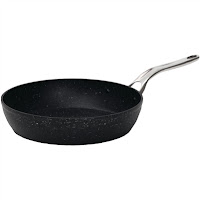In the late
17th and late 18th century a skillet was a cylindrical vessel having a hinged
lid, a handle and sometimes feet. Later skillets had a flat bottoms used on
hearths. New cook stoves with flat cooking surfaces called "dampers"
came in to use in the 18th century.
A skillet is
a flat bottom pan used for frying food items; often called a frying pan or
simply a fry pan. The skillet sides are smaller, which flare outwards slightly.
It is an open pan with no lid and has a long handle. Skillets have a variety of
purposes in terms of cooking but mostly for frying and browning methods during
cooking. There are many types of skillets available with various dimensions in
the length and width of the circular sides. Newer skillets come with an angular
handle for better usage and handling. Make sure your handle is ovenproof if
used in today's ovens.
Cast Iron
and Copper Skillets
A skillet is
popular with chefs all over the world, more so with chefs preparing meat
dishes. Skillets traditionally produced from copper and cast iron, however
today many other different metals are used. Copper is popular due to its
excellent heat conductivity, although popular, copper skillets need extra care
in cleaning and general maintenance due to tarnishing which requires polishing regularly.
Cast iron
skillets have a major worry of rusting if washed from time to time. Chefs wipe
the cast iron frying pan after every use but there is a chance that previous
frying may affect the next frying session in terms of taste.
Cast iron was invented in China during the 5th
century BC. Poured into molds it made ploughshares and pots as
well as weapons and pagodas. Although steel was more desirable, cast iron was
cheaper and thus more commonly used for implements in ancient China, while they
used wrought iron or steel for weapons; cast-iron skillet may seem like an
old-fashioned cookware choice. However, this dependable object is necessary in
the modern kitchen. Cast iron conducts
heat beautifully, seamlessly transitions from stovetop to oven and lasts for
decades. In addition, cooking with cast iron can be good for
your Health.
Other Metals
Used for Making Skillets
Aluminum often
used requires very little maintenance, and like copper is an excellent
conductor of heat. However, if you take durability, heat conductivity and
maintenance in to the scheme, skillets made from stainless steel are still
better and more popular.
During
cooking, aluminum dissolves
most easily from worn or pitted pots and
pans. Leafy vegetables and acidic foods, such as tomatoes and citrus products,
absorb the most aluminum. Cooking
or storing food in aluminum pans for a long period of time is not advisable due
to absorption of small amounts of the metal.
Teflon
Coating Used in Skillets
Skillets
used for frying, have a constant problem of food material sticking to its
surface. Along came the skillets with a non-sticky coating known as "Teflon"
coating. The only problem with this non-sticky coating is that it may peel off
after a considerable amount of usage and may and will scratch easily by use of
metal tools therefore, recommended are specialty tools or wooden spoons.
The type of
skillet for usage is a personal question as some people are used to a certain
type of metal-made skillet. If we are talking about numbers, the Teflon coated
skillet is one of the most popular.
At TheUpScaleKitchen we are always searching for new recipes, places to visit
and tips to share. Some recipes are from
our family some we find while researching topics for our blog. We want to hear about your experiences please
leave your comments below. Also like us
on FaceBook
and follow us on twitter.

Comments
Post a Comment